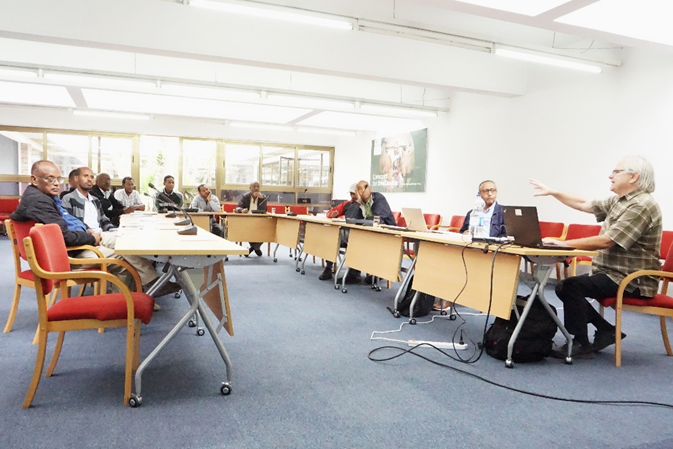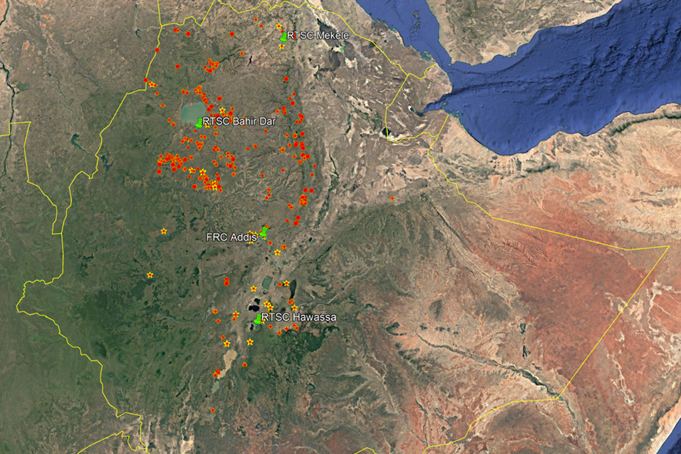
By Eyob Getahun
Farmer groups that collect tree seed should be matched with quality seed sources to help boost land restoration efforts in Ethiopia, according to participants at a recent workshop.
The event, which took place in Addis Ababa on 25 March 2025, aimed to prepare a model for aligning farmer tree seed collectors with identified and described seed sources, as well as breeding seed orchards (BSOs) and seedling seed orchards (SSOs).
The workshop was part of the second phase of the Provision of Adequate Tree Seed Portfolios (PATSPO II) project, financed by the Norwegian International Climate and Forest Initiative (NICFI) through the Royal Norwegian Embassy in Ethiopia (RNE).
Professionals from regional tree seed centres, researchers from Ethiopian Forestry Development (EFD), and PATSPO II staff participated in the workshop.
“Aligning well-described seed sources with seed collector groups is necessary because good tree seed sources mean good seed, and good seed produces trees that are productive,” said Jens-Peter Barnekow Lillesø, a tree seed expert from the University of Copenhagen.
Ethiopia has embarked on an ambitious forest landscape restoration programme with a commitment to restore more than 20 million hectares of degraded forests by 2030. Tree-based land restoration requires the use of many tree species at the same time. But a supply of genetically diverse, healthy and productive tree species is not readily available.
PATSPO, which launched in 2017, has worked to make available and ensure access to high-quality seeds of the most important tree species for forest landscape restoration and tree-planting activities in Ethiopia. The project’s second phase – which is now in its final year – is building on the achievements of the first phase by developing more breeding seed orchards and registered seed stands, and by training regional tree seed centres, private seed dealers, and farmer groups that collect tree seed.
Tree planting is an integral part of the Ethiopian government’s policies, with 95 percent of the country’s nurseries being managed by regional bureaus of agriculture, according to Lillesø. The people working in agriculture think the seed they are sowing is good if the germination percentage is high, “but what matters most is the genetic quality of the seed,” he said. In the Ethiopian highlands, private seed dealers supply around 40 percent of tree seed to nurseries; nurseries collect around 30 percent of their seed; and government-owned regionaltree seed centresdeliver 30 percent of the tree seeds, according to Lillesø, who conducted a study on the topic in 2019 along with Abayneh Derero, a researcher at EFD.

Government seed centres and private tree-seed suppliers buy seed collected by farmers. Farmers thus play a vital role in the Ethiopian tree seed sector. The government-owned tree seed centres work closely with farmer seed collection groups. The farmers are trained and provided with seed collection tools and equipment by the PATSPO project in collaboration with the regional tree seed centres.
Tree seed sources have been identified by EFD and regional tree seed centres in different parts of the country. The workshop’s participants learned that most of these sources are not used by farmer tree seed collectors, who rely on the random and undocumented seed sources closest to where they live – in farmlands, plantations, and natural forests.
Nurseries also collect seed from undocumented seed sources, while private dealerssource seed through local collectors and sell to large government-supported tree-planting initiatives in agricultural development programmes. In most cases, price is the only quality criterion.
Realizing the absence of farmer groups near some of the described seed sources, participants from the regional tree seed centres have agreed to organize new farmer seed collector groups within 5–10 kilometres of the identified seed sources, according to Belete Getnet, a PATSPO research officer who participated in the workshop.
“There are groups that work in areas where there are no well-described tree seed sources,” said Lemma Kitila, head of the Dima Tree Seed Center. “And there are tree seed sources where there are no farmer groups in the vicinity. We have now planned to train farmers living near the described tree seed sources so that they could be organized in a cooperative and collect from the identified seed sources.”
“All of the plantations that we select as seed sources are owned by Oromia Forest and Wildlife Enterprise,” Lemma said. “Once the seed sources are well described and identified as seed sources, I write a letter to the branch that manages the plantation so that the trees in the seed source should not be cut down for at least 10 years.” Asked if they ever stopped buying seed from certain farmer groups, Lemma answered, “We stop buying seed from seed collector groups when seed sources get old. In some cases, the tree seed collectors themselves become too old to climb trees. In other cases, when members of a group get a good amount of money from the sale of seed, they engage in more profitable businesses and stop collecting seed.”

| Symbol | Type of seed source | Symbol | Collection |
|---|---|---|---|
| Plantations | Seed collection group | ||
| Farmland | Seed centre | ||
| Natural forest | |||
| BSOs-SSOs |
Using seed zone maps of Ethiopia’s priority species and by mapping the identified seed sources, farmer groups and the regional tree seed centres on Google Earth, Lillesø is working to develop a modality through which PATSPO II can support the regional tree seed centres to ensure the farmer groups are collecting tree seed from the identified tree seed sources and the established BSOs and SSOs.
PATSPO II was launched in April 2022 with the motto ‘Transforming the Tree Seed Sector in Ethiopia’ and is to be implemented until December 2025. The Center for International Forestry Research and World Agroforestry (CIFOR-ICRAF) is responsible for the implementation of the project, in coordination with the Ethiopian Forestry Development (EFD), NICFI and the RNE.



















